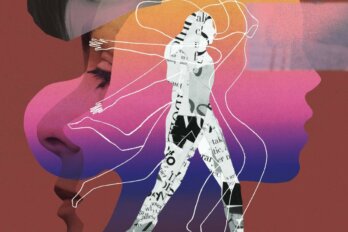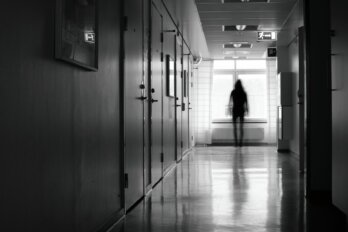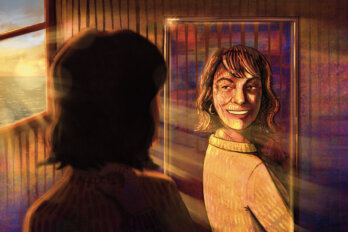It is 9 a.m. on a Saturday, and I am sitting in a little wooden boat with my son. He is fidgety, restless with excitement, practically bouncing against the large metal bar on our laps. A bell rings, and we begin moving in a circle, slowly at first, following the swells and dips of the waves. Then we speed up. My son grabs the helm in front of us and turns it several times, swinging our boat around. We are moving backwards fast, and my stomach is turning. I take the wheel and right our boat, but now the light goes out. Before I know it, my son has spun us around again.
He is laughing. It is his first amusement park ride, and he’s keen to squeeze every last drop of thrill out of it. I have spent my life avoiding thrills. My son is ten and tall enough for roller coasters. I am forty-one, and I have only ever been on one. I always find a reason to stay away. Someone needs to take care of the smaller kids, I say. Or: I’m not interested. It’s not my idea of fun. Who knows what could go wrong? Do I really trust the technical know-how and safety expertise of seasonal carnival workers and distracted teenagers? Didn’t I read once about riders getting stuck midtrack and being left to hang upside down?
I’m not scared, I tell myself. I’m just rational. Prudent. Worry has always seemed a friend to me. I’ve broken no laws and no bones, and I like it that way. At other times, safety demands a sacrifice, and the past few years have taught me the price I’ve paid for my second guessing. I’m the person who rents a Vespa but chickens out after gunning it a few metres; who turns back from a hike because a knee starts to ache; who sits on top of a mountain, strapped to a snowboard, crying. My fear makes me a comfortable quitter.
Around me, too, I have been watching how fear imprisons as it protects. When the pandemic began, my mother did not leave her apartment for five weeks. In the months that followed, my family members succeeded in staying free of the virus, but the stress of confinement made them ill. While they tracked daily infection numbers, I tried to keep count of the number of times they were hospitalized for other reasons: panic attacks, digestive problems, heart palpitations. When the restrictions began to lift, the anxiety stayed. I found it difficult to convince friends and family to leave their homes, even once it was reasonable for them to do so.
Fear promises control over the chaos of life, but most of life remains stubbornly unbiddable. For inspiration, I turn to Laurence Gonzales’s Deep Survival to read about people unlike me, people who fly fighter planes, climb snowy mountains, and try to cross oceans alone. “Survivors aren’t fearless,” writes Gonzales. “They use fear: they turn it into anger and focus.” After decades of chasing safety, I decide, I’m no longer willing to pay the costs of a life that avoids risk. I’m willing, at last, to be afraid.
On this sunny Saturday in June, I will become a person who rides roller coasters. Our backwards-in-circles ride in the wooden boat is meant to be our warm-up, and indeed, all the four- and five-year-olds disembarking look happy. I seem to be the only one who is shaking. It is going to be a long day.
The funny thing about my fear of roller coasters is that it is not really mine. I have no problem with heights. I love fast cars and high-speed trains. There was a moment in my life when I was prepared to love roller coasters too. I was around eleven, visiting Disney World with my family. We tried a few attractions: the Mad Tea Party’s spinning teacups, which made me queasy, and one of those so-called “dark rides” that pass through spooky sets with creepy human figures moving in unnatural ways. Bored, my father and I were ready to try a modest roller coaster. My mother was not and opted to wait on a nearby bench instead. We had been in line for a while when she came, agitated, and pulled us out. She had seen a kid come out of the ride, shaken and sick. There was no way she would let the same thing happen to me.
I remember being angry at this mysterious child for spoiling my fun. I was not scared, nor was my father, but we had no choice other than to placate my mother. We spent our remaining time at Disney World doing things like watching cartoonists draw Mickey Mouse and complaining about the cost of the food. Without my even knowing it, though, I had absorbed some of my mother’s fear. In the following years, the “little green barfing kid,” as I called him, became a joke I told my friends as an excuse for not going to amusement parks. At some point, they dragged me to Wonderland and onto the Ghoster Coaster, whose humps and banked curves had been designed for children. I spent the entire minute and a half of the ride feeling my stomach drop into my bowels, terrified that the wooden posts would splinter under me. I never did it again.
It’s not a tragedy to spend a lifetime avoiding roller coasters. But it is troubling that, when I look back on my life, my best decisions are those in which I was willing to countenance risk: studying literature instead of medicine, telling the man who would become my husband that I loved him, having a child when I was expected to focus on my career. Now I wonder: What else have I missed out on because I’ve mistaken someone else’s fear for my own good sense?
Most of all, I no longer want to be the scared mother in my son’s story.
Our first proper coaster together is an adorable little Alpine train. It is the oldest ride in the amusement park, and so short they run it twice before letting people off. The locomotive pulls us along a few gentle curves through the canopy of trees before going into a dark diamond mine with bright flashing lights. I scream most of the time, as does my son. When we leave the ride, he is yelping with happiness, flailing his arms like Kermit the Frog. One thing my fear has deprived me of, I see now, is the chance to share this silly wild joy with my son.
Only later does it occur to me that that is a pleasure my parents also missed out on. I understand why. By the time we arrived in Canada, we had survived a totalitarian regime in one country and a civil uprising in another. My parents wanted peace, indoor heating, and a fridge full of food. I’m not surprised that they did not immediately gravitate to forms of entertainment that involved jumping out of your skin. Immigrant life is already a roller coaster—not the gleaming, modern kind you find at a pricey amusement park but one of those rickety structures hammered into the ground at a temporary fair. It is a rush into the open air with nothing below your feet, followed by loop after loop after loop.
My son and I move on to a water coaster that takes us so high we can see the hilly landscape for miles around. I notice a single crane standing on a chimney under the endless blue sky before we fall backwards. We shoot lasers at neon cartoons on a dark ride and whiz around the half pipe of a bobsled roller coaster. At some point, I start to feel that I’m cheating. None of the rides I’ve gone on are the mega coasters that define the park’s skyline. The day has been too easy, almost anticlimactic.
I ask my son if he wants to go on one of the big coasters, but he says no. It is his first day at an amusement park, and he has nothing to prove, so I leave him with his father and set out on my own. I don’t know if my bravado at this point is ignorance or an attempt to trick myself, but I gamely choose to sit in the front row, alone. It all seems doable now—even when I have to put my glasses and purse in a bin, even as the restraint lowers onto my lap.
The coaster shoots out of an open door and takes me around a large loop and three monstrously tight twists and rolls. With nothing on my shoulders and no one in front of me, I feel like I am falling through the sky. At some point, screaming “Oh my God” stops being a solace, and I close my eyes, wishing for it to be over. When I finally stumble out, my body quakes with terror, and I struggle not to be sick on the platform.
At the exit, where they sell photos and videos of the ride, two teenage girls are so amused by my clip that they don’t notice me standing next to them. “It was my first time!” I say to them indignantly, and they are silent for a second before they coolly return to laughing at the sight of me: almost in tears and begging for my life.
Iwish I could say that doing the thing that scared me most gave me a rush of confidence, that I now feel capable of taking on any challenge. The truth is that I was on edge for hours. Besides, my deeper anxieties, the ones that substantially shape my life, are not so easily overcome. There is no sixty-second ride that will keep me from worrying about being a disappointment or a failure or, worst of all, a success. My normal life is more like those long lines before the rides begin: slow, boring, with a lot of talking, and no clear end in sight.
Maybe that’s why my favourite roller coaster that day was one that kept us in the dark. My son and I took a long, slow ride to the top of an enclosed sphere before plunging through tunnels lit by occasional flashing lights. We sat in the front row: ahead of us was only blackness. To my surprise, it was freeing not to know what would happen next. Over the years, I have done so much to be in control. Here, I couldn’t even see a metre ahead of me. I could finally let go.




